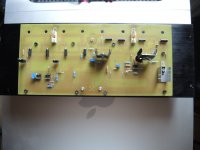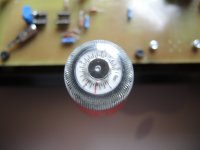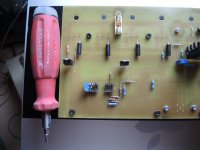No, all I wanted is just to speed up the process of tapping this 20 holes /per heat sink.If you really want to get heavy into power tapping you could look into a tapping head like a Tapmatic self reversing, but they aren’t a cheap solution!
And these tabs hold more than I need.
The Transistor bolts will be fastened with 2.0 Nm (nano meter)..using a Torque wrench (some kind of a screwdriver with a release clutch) when torque has been reached. So all Transistors are screwed down with the same torque, assuring heat transfer from transistor to heat sink to be the same for all. I think for any Multi Transistor Amplifier on the output it's very important that these are all fitted with the same torque or force, but especially for Class A, as here current is never switched off.
@lgreen
Thank you . you hit the nail on the head.. it's exactly that way.
This will work also on Metal to the thickness of about 3 mm after that the drill has not enough torque.
@NareshBrd can not be used in that heat sink it will cut down the heat transfer dramatically by the steel and it's too much work to fit.. I know that kind of REPAIR items for broken down TABS.. but here the size is only 3mm in diameter..
BIG sorry pics aren't sharp enough and I'm in a hurry.. went to bed 3am and now it's 8:30 and should be on my way to work.. but this here has priority..
I hope the amp gives his first sound today.. board hasn't been assembled completely..
Thanks to everyone..
Attachments
Last edited:
I use plenty of WD40 too.
Nigle, please understand this the right way. and I do not want to teach you. I respect you, and if this works out for you then OK with me.
But WD40 is not the way to go, while TAPPING..
Reason: WD40 is a cleaning solution with no Lubrication qualities because it's not a lubricant.
That's why you need a lot.. Use drilling or cutting fluid, which is in fact cheaper to buy.
Regards Chris
Last edited:
The diameter of the whole I drilled to get this 3mm Tabs in is 2.4mm
When I use hand tapping it will be 2.6mm otherwise the tabs are not really good
this is because with hand tapping you will need DOWN FORCE for the first two threads and there is a huge possibility to make something wrong.
With that little battery driven Tool, there is NO DOWN FORCE REQUIRED. Just holding it straight is more than enough
Thanks for reading and thanks for any input..it appreciated.
All I try to do here is to give something back to community of DIY Audio.
I have not even a tiny bit of thought to become Famous here, there already enough famous people here..
I just appreciate to post here and it's a honor to be able to write here.
One of my guideslines all my life, without a small risk no success.. Hey soon I'm turning 70- next year thou..
That's why I do what I do and I do it the way I think it's correct, if not then I'm first in row, to accept other peoples point of view.
Thank you guys.,.
Chris
When I use hand tapping it will be 2.6mm otherwise the tabs are not really good
this is because with hand tapping you will need DOWN FORCE for the first two threads and there is a huge possibility to make something wrong.
With that little battery driven Tool, there is NO DOWN FORCE REQUIRED. Just holding it straight is more than enough
Thanks for reading and thanks for any input..it appreciated.
All I try to do here is to give something back to community of DIY Audio.
I have not even a tiny bit of thought to become Famous here, there already enough famous people here..
I just appreciate to post here and it's a honor to be able to write here.
One of my guideslines all my life, without a small risk no success.. Hey soon I'm turning 70- next year thou..
That's why I do what I do and I do it the way I think it's correct, if not then I'm first in row, to accept other peoples point of view.
Thank you guys.,.
Chris
Last edited:
Ah! Here is River Rouge Ford plant making Flathead V-8s. I've set the time to the end of the cylinder boring, just before they drill and tap ALL the headbolt holes. In about 12 seconds.
The Ford Rouge Plant 1941 - YouTube
BTW: this machinery (or sisters) was also used to make the 289 series V-8. Which explains only some of the oddities of the smallblock.
This (most probably) is the guy (and machinery) making the UMS-heatsinks for _the_ store! (After his 289 V-8 shift of course)
The diameter of the whole I drilled to get this 3mm Tabs in is 2.4mm
When I use hand tapping it will be 2.6mm otherwise the tabs are not really good
this is because with hand tapping you will need DOWN FORCE for the first two threads and there is a huge possibility to make something wrong.
This 0.2mm tolerance probably eases the making of a tap, but you give away around 1/3 of the tap‘s diameter, and lose quite some stability (of the tap holding the screw)…
Either way (manual or electrified), if you haven‘t access to a precise pressdrill, I recommend using a drill-remplate to ensure the angularity of the production-process. But that’s me and my shaking hands writing this. [emoji1787]
Yeah my friend according to what I have learned in Gewerbeschule 1968 GIBB
(Mechanical Trade School) in Bern
is the rule of thumb 3mm: 0.8. and I never seen any problem with this till today.
I will use 2.6 when using my manual tool.
So tell me how much would you drill the hole.?
I need max 2Nano Meter torque for fastening the transistors. The Tabs I make withstand over 5 Nano Meter and after that the go down the drain..
Yes and I have access to professional equipment to make tabs.. in My Garage where we restoration old Ancient Cars..
But you see it's 65 Km away and therefore the Way I do this here is more than efficient and OK for me.
Thanks
Regards
Chris
(Mechanical Trade School) in Bern
is the rule of thumb 3mm: 0.8. and I never seen any problem with this till today.
I will use 2.6 when using my manual tool.
So tell me how much would you drill the hole.?
I need max 2Nano Meter torque for fastening the transistors. The Tabs I make withstand over 5 Nano Meter and after that the go down the drain..
Yes and I have access to professional equipment to make tabs.. in My Garage where we restoration old Ancient Cars..
But you see it's 65 Km away and therefore the Way I do this here is more than efficient and OK for me.
Thanks
Regards
Chris
I am old school tapping so tend to do it the way this video does it.
How to tap steel | tapping steel | ultimatehandyman - YouTube
How to tap steel | tapping steel | ultimatehandyman - YouTube
yes Exactly this way is very good for STEEL..
Aluminum is much softer. the chance to break the tab is a lot bigger..
Also I use Is hot drills.. for aluminum
Aluminum is much softer. the chance to break the tab is a lot bigger..
Also I use Is hot drills.. for aluminum
N-m is Newton-metre, a measure of torque...
And there is a tractor factory here, they had Cruzet-Loire (French) machines here for the engine and gear box production.
Or it was the brand of the electrical contactors inside?
Multiple spindles, and multiple diameters, all in the same operation.
But those are mass production machines set up by experts with proper tooling, we have a much smaller scale here in terms of holes per hour..
WD40 is simply transformer oil with a little lube added, and environmentally a disaster, most of the can is propellant, ozone layer hazard.
Use 5W-30 or light sewing machine oil for tapping. Just dip or use a small children's paint brush. You can even use old engine or gear oil.
And there is a tractor factory here, they had Cruzet-Loire (French) machines here for the engine and gear box production.
Or it was the brand of the electrical contactors inside?
Multiple spindles, and multiple diameters, all in the same operation.
But those are mass production machines set up by experts with proper tooling, we have a much smaller scale here in terms of holes per hour..
WD40 is simply transformer oil with a little lube added, and environmentally a disaster, most of the can is propellant, ozone layer hazard.
Use 5W-30 or light sewing machine oil for tapping. Just dip or use a small children's paint brush. You can even use old engine or gear oil.
Last edited:
rule of thumb 3mm: 0.8. and I never seen any problem with this till today.
I will use 2.6 when using my manual tool.
So tell me how much would you drill the hole.?
I use a plain and banal 2.5 for lack of the 10th mm drills. Since I did the last dozen by hand without proper guides, not all taps are what they‘re supposed to be and I concluded I need to improve on both my equipment and my skills…
You‘re rule of thumb I can‘t relate, what does it mean?
Best
David
It means the hole you drill to place the thread for all under 5mm TABS, should be calculted by 0.8
So if you want a 3mm Threaded TAB then 3*.8=2.4mm
This is only correct for tabs not over 5mm
If you use a hand drill then this 2.6mm will be 2.6 unless you use a STANDALONE DRILL MACHINE.. I use a Standalone Drill machine but then I use 2.4 because even then it's going to be larger than 2.4 so I'm within limits and specs.
Hope to have answered your Question.. The tool I show garanties no BAD TABS.. because the operator does not need to use FORCE or pressure just holding straight is more than enough and you will get real nice tabs.
So if you want a 3mm Threaded TAB then 3*.8=2.4mm
This is only correct for tabs not over 5mm
If you use a hand drill then this 2.6mm will be 2.6 unless you use a STANDALONE DRILL MACHINE.. I use a Standalone Drill machine but then I use 2.4 because even then it's going to be larger than 2.4 so I'm within limits and specs.
Hope to have answered your Question.. The tool I show garanties no BAD TABS.. because the operator does not need to use FORCE or pressure just holding straight is more than enough and you will get real nice tabs.
- M1 - Ø 0,75 mm.
- M2 - Ø 1,6 mm.
- M3 - Ø 2,5 mm.
- M4 - Ø 3,3 mm.
- M5 - Ø 4,2 mm.
- M6 - Ø 5 mm.
- M7 - Ø 6 mm.
- M8 - Ø 6,8 mm
I have been doing the same or similar as you using a McMaster-Carr M3x0.5 drill tap for my Al heatsinks. Using a number drill close to 2.5mm on the drill press, a hand drill for the drill tap, 3in1 machine oil for lub. I must have done a few 100 by now with good success. No blind holes, tapped all the way through. Works like a charm for me.
@ rsavas
Thank you..
I see I'm not alone..
Why wasting time hours for hours just to get few tabs done..? I do not get that point..Guys you do not have to lose anything, you can only win. Win precious Time to spend, doing more important stuff than cutting TABS,
Regards
Chris
Thank you..
I see I'm not alone..
Why wasting time hours for hours just to get few tabs done..? I do not get that point..Guys you do not have to lose anything, you can only win. Win precious Time to spend, doing more important stuff than cutting TABS,
Regards
Chris
I've been doing it with an electric drill for 20+ years, never broke a tap. M2.5 and up. I do lubricate the tap before starting, and you need a steady hand, but it works like a champ.
Don't be mislead by thinking that in manual mode your hand will be more steady. It isn't, because you repeatedly have to change your grip. Electric drill, especially the type that can switch directions with a switch that you can actuate without changing your grip, is way more steady and controllable.
I use the same drill calculation as hpro showed above.
Jan
Don't be mislead by thinking that in manual mode your hand will be more steady. It isn't, because you repeatedly have to change your grip. Electric drill, especially the type that can switch directions with a switch that you can actuate without changing your grip, is way more steady and controllable.
I use the same drill calculation as hpro showed above.
Jan
I have a DeWalt LiIon battery hand drill with the direction switch close to the trigger/ speed control, it even has a couple of leds to light up the work area, boy are we ever fortunate to have these fine inexpensive tools available.
I regularly tap hole in brass ( 1/4 whit ) at 1,200 rpm, the workpiece turns in the lathe, I center drill ( with a modified broken tap - I like to get as much use as I can from HSS ), drill - then I have a special tap holder that fits over the drill to keep it straight, I grip it in my left hand untill it reaches the end of the tread and let it slip. The advantage is the thread is slightly larger when taped at speed than by hand. I've seen someone taping cast iron with a battery drill, I can't remember him breaking a tap.
...
The Transistor bolts will be fastened with 2.0 Nm (nano meter)....
The max torque for the TO-3P, TO-247, TO-264, etc. is 0.8 N.m, according to OnSemi, Renesas, Sanken, Toshiba, etc..
This is barely more than finger tight.
Also of interest, as shown by the OnSemi paper: minimum thermal resistance is achieved at half the rated torque value.
If I use that torque, then switching on the amp would create a nice firework,,, And it would not wait for next years August 1st.
I read some of the ON SEMI but it's quite misleading as they use KGF instead of Nm..
Anyway the tool I use, is adjustable 0. - 5 Nano meter.. for the bolts I use, I adjust it to 2.0 max 2.2 depends where the aluminum heat sink comes from.. and who made the TABS..
But thanks anyway
Regards Chris
I read some of the ON SEMI but it's quite misleading as they use KGF instead of Nm..
Anyway the tool I use, is adjustable 0. - 5 Nano meter.. for the bolts I use, I adjust it to 2.0 max 2.2 depends where the aluminum heat sink comes from.. and who made the TABS..
But thanks anyway
Regards Chris
- Home
- Design & Build
- Construction Tips
- Threading the easy way, Cheap Fast and excellent Quality


